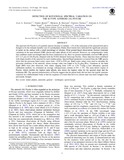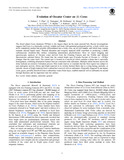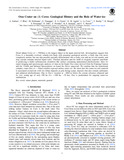Browsing Department of Geography by Subject "minor planets"
Now showing items 1-3 of 3
-
Detection of rotational spectral variation on the M-type asteroid (16) Psyche
(The Astronomical Journal, 2016-12-28)The asteroid (16) Psyche is of scientific interest because it contains ∼1% of the total mass of the asteroid belt and is thought to be the remnant metallic core of a protoplanet. Radar observations have indicated the ... -
Evolution of Occator Crater on (1) Ceres
(The Astronomical Journal, 2017-02-17)The dwarf planet Ceres (diameter 939 km) is the largest object in the main asteroid belt. Recent investigations suggest that Ceres is a thermally evolved, volatile-rich body with potential geological activity, a body which ... -
Oxo Crater on (1) Ceres: Geological History and the Role of Water-ice
(The Astronomical Journal, 2017-08-04)Dwarf planet Ceres (∅ ∼ 940 km) is the largest object in the main asteroid belt. Investigations suggest that Ceres is a thermally evolved, volatile-rich body with potential geological activity, a body that was never ...



